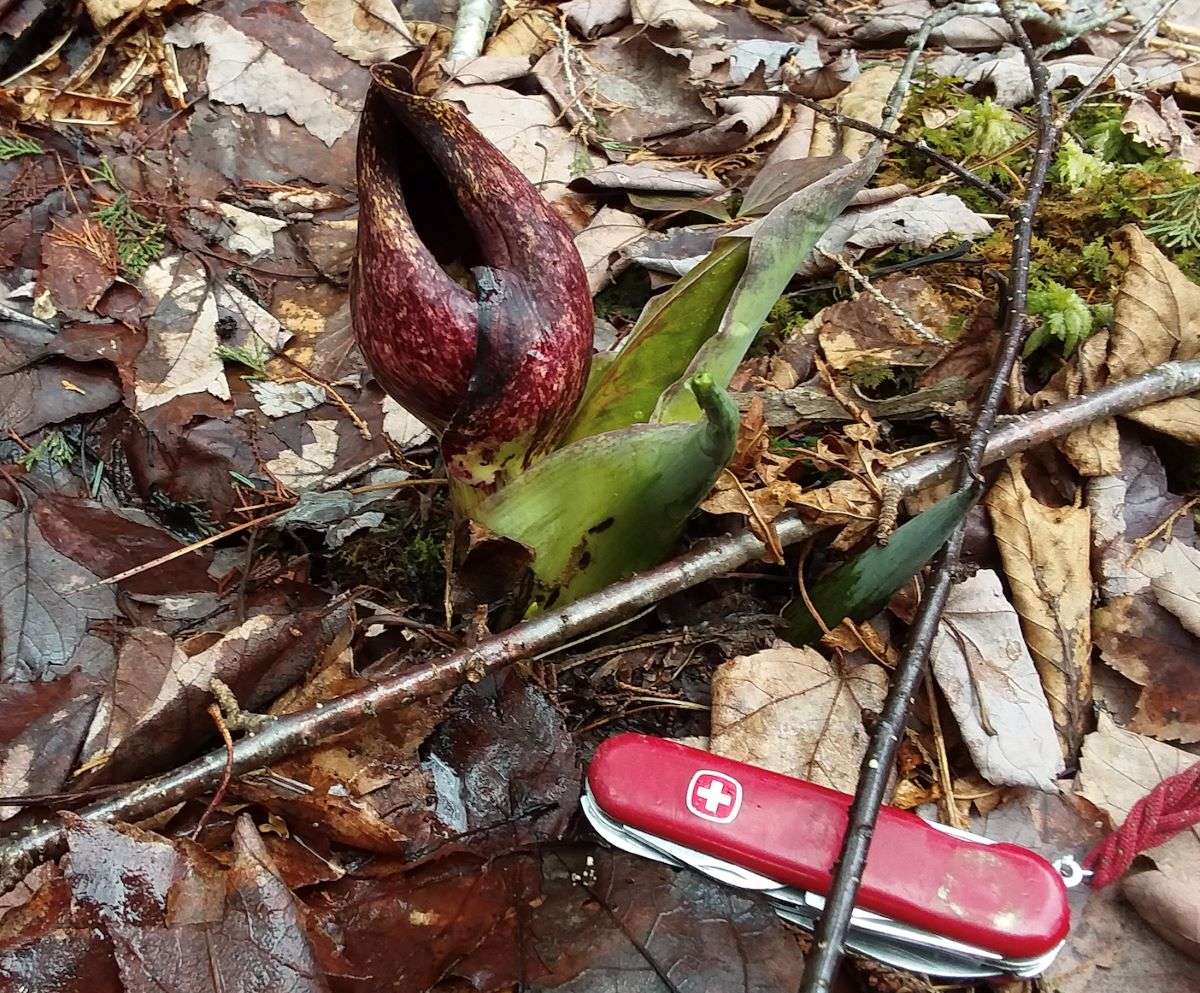Out in the Woods
- March 29th 2024
- Out in the Woods

As Shoots Push Upward, Skunk Cabbage Warms the Soil
Skunk cabbage at Great Works Reserve
Photo: Kevin McKeon
By Kevin McKeon, Director, Mousam Way Land Trust
Kindly described as having a “fresh cabbage scent with a slight suggestion of mustard,” skunk cabbage’s botanical name, Symplocarpus foetidus, roughly translates to “bad-smelling compound fruit” and nature has reasons for this infusive adaptation.
It blooms in very early spring, prior to the arrival of most pollinators. Skunk cabbage’s rotten odor and liver-colored streaks attract carrion-seeking flies and small beetles to its spadix, a spike of small yellow flowers sheltered inside the plant’s spathe, a thick, fleshy, protective leaf growth with Styrofoam-like texture. This odor-attraction adaptation, increasing as it matures, is called dung mimicry, and the bugs thus attracted to this ground-hugging plant often linger due to the plant’s “warm” welcome – a bit more on this later. These visiting bugs, along with early-foraging honeybees, are the skunk cabbage’s pollinators, but spiders are apt to nab them with webs woven across the spathe’s opening. So, this early spring micro-habitat offers some respite (and traps) for various critters of the skunk cabbage’s forested wetlands.
These plants form thick, underground stems called rhizomes, from which roots and leaves emerge. After blooming, its roots contract in a sort of shriveling adaptation, pulling it closer to the ground for protection. Skunk cabbage may grow for hundreds of years with extensive, persistent root systems if its habitat isn’t disturbed; the rhizomes grow to be a foot thick. The summer leaves appear tropical, growing up to three feet tall.
Roots of skunk cabbage contain oxalic acid and are toxic, but rarely fatal. It tastes so bad that eating a lethal amount would be difficult. But after neutralizing the acid by drying the plant, or by several lengthy cookings, Native Americans used the rhizomes and leaves as food and medicine, treating toothaches, asthma, bruises, blisters, scurvy, headaches, and more.
Surprisingly, skunk cabbage’s odor and toxicity, which increases as it matures, are not bothersome to some wildlife; muskrats, bears, turtles, turkeys, and geese have learned to partake of its early, low-toxic growth. Squirrels, grouse, pheasants, and wood ducks eat the seeds. Snails and slugs go for the leaves and a host of microorganisms feed on the decaying vegetation.
So, let’s talk about skunk cabbage’s “warm” winter welcome – thermogenesis or heat creation.
Skunk cabbage generates heat similar to the way we and other mammals do. It uses oxygen to break down stored starches during growth, but some molecular exchanges are incomplete. Science describes this as “wastefulness,” and heat is the by-product. A deeper dive into this process is here, under Alternative Oxidase: https://www.sciencedirect.com/topics/agricultural-and-biological-sciences/skunk-cabbage. When the soil temperature reaches 32° F, the spadix warms the inside of the spathe, the spathe’s Styrofoam texture insulates the spadix, and wind enters and circulates in a vortex that keeps the inside temperature stable at about 72° despite winter’s cold air.
Folks at the In Defense of Plants website https://www.indefenseofplants.com say, “the spadix is hooked up to a massive underground energy reserve largely in the form of carbohydrates or sugars.” The heat thus produced melts the spring snow as the plant pushes through, blooming at ground level before the ground thaws, with the heat helping to disperse the pollinator-attracting scent.
So, what does it really smell like? The safest way would be to get your nose near ground level and sniff it while peeking at the flowering spike within. Removing a piece might result in acid transfer, so awareness of where you put your fingers afterwards is strongly suggested. After partaking of this plant’s scent, wonder at the first human that decided to eat it!






